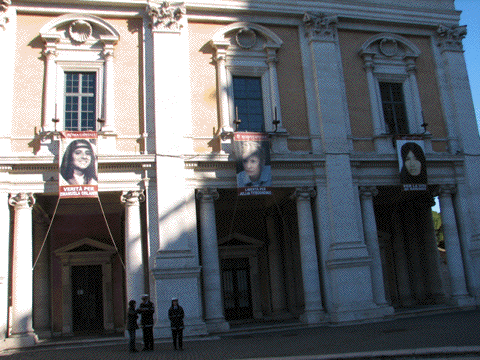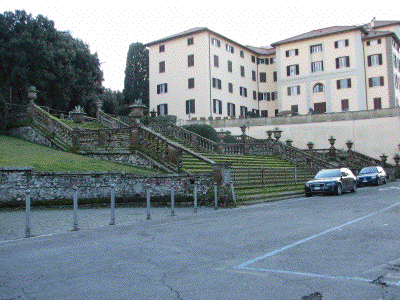Sue Lange's Blog, page 11
March 26, 2013
Me and Kurt
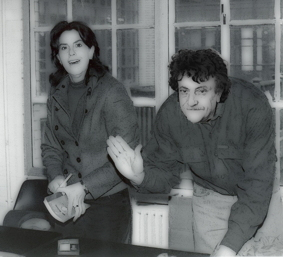 The folks at Perpetual Motion Machine Publishing (Max Booth III and Lori Michelle) have decided they love Kurt Vonnegut. In fact they love him so much they’re publishing a Kurt Vonnegut tribute anthology. And being in possession of fine taste and exquisite judgment, they’re including my story, Megastar Hopper.
The folks at Perpetual Motion Machine Publishing (Max Booth III and Lori Michelle) have decided they love Kurt Vonnegut. In fact they love him so much they’re publishing a Kurt Vonnegut tribute anthology. And being in possession of fine taste and exquisite judgment, they’re including my story, Megastar Hopper.
That is cool on so many levels. First off, I love Kurt. But then, everyone does, so nothing unusual there. Further than that, though: me and Kurt, we go way back. All the way to the 90s when I had a part time job with a publisher on East 47th Street, over by Second Avenue in Manhattan.
You know where this is going because you know Kurt lived on 48th by Second Ave for a good portion of his life. It was inevitable that I would develop a relationship with Kurt being in such close proximity to him for a goodly portion of every business day.
Interestingly this Second-Avenue-47th-48th –ish neighborhood has many claims to fame besides Kurt. Sparks Steakhouse, where Gotti had Paul Castellano plugged, is on 46th between 2nd and 3rd. And the corner of 47th and First Avenue is where Donald plopped the Trump World Tower. You remember the controversy there. The neighborhood folks, headed up by Walter Cronkite, got pissed at the egomaniacal height of the building and started an anti-Donald’s-new-big-building campaign. Unfortunately for Walt et al., Trump had bought up the neighborhood’s aerial rights and easily won the suit. He’d also been in the business long enough to know who to pay off to get things done. So today 47th Street is blessed with what amounts to another of Trump’s big phal…nevermind. Just take a look at the shot on the right there and come to your own conclusion.
 Across First Avenue from Donald’s big you-know-what, is the United Nations. Because it’s agin’ the law to protest on UN property, everybody holds their big anti-world government rallies in Dag Hammerskjold Plaza between First and Second Avenues on 47th. It’s across the street from the building housing my old office.
Across First Avenue from Donald’s big you-know-what, is the United Nations. Because it’s agin’ the law to protest on UN property, everybody holds their big anti-world government rallies in Dag Hammerskjold Plaza between First and Second Avenues on 47th. It’s across the street from the building housing my old office.
It is reported that Kurt used to sit with his dog on one of the benches in Dag’s plaza. I never saw him there, but I did see him once walking west on 47th Street. It was around noon and so I can only assume he was headed for lunch. Probably at Sparks.
On the occasion when I spotted Kurt, he was alone and muttering to himself. This was before Blue Tooth so he wasn’t on the phone. Despite that I’m quite sure he wasn’t losing it and talking to himself the way crazy people do. I know this because in Manhattan famous people walk around talking to themselves all the time. It’s a technique they use for privacy.
As you know, the only way to avoid overlong and nonsensical conversations with lunatics is to avoid eye contact. Because of the high percentage of nut jobs in New York City, New Yorkers know from birth to not engage crazies. The minute a New Yorker notices someone talking to him or herself, they start admiring the tops of buildings, the strength of the scaffolding on the lower floors, the gum stains on the sidewalk. The sad thing is, they miss so many opportunities for star gazing. They often realize it later, in the late hours as they get ready for bed, that the bag lady talking to herself over on Lexington was actually Jay Lo or Dr. Phil on their way to a workout session. Another opportunity missed.
It happened quite often to me. In the course of a typical day in Manhattan I’d run into ten or twelve crazies. Well, maybe five or six certifiables and another half dozen wannabe starlets strung out on street drugs because they can’t seem to get a break. At any rate, a couple of times a year, it’d hit me later as I’m getting ready for bed, that one person that day was neither a wannabe actor nor an escapee from Doctor Feelgood’s Lithium Emporium upstate. It was Somebody Famous.
Famous people I would have seen talking to themselves if I hadn’t been admiring the mound of trash by the curb include:
1) Christopher Walken. (Not sure he was actually using a technique, though. I mean…it’s Christorpher Walken. He’s just naturally that way.)
2) Eddie Murphy
3) Walter Cronkite
4) Jesse Jackson
The last one, Jesse, wasn’t really talking to himself. This was during that phase of his life when he was mustering a constituency for an attempt at the presidency. The day I saw him he was on a 48th Street sidewalk addressing a group of about 20. In terms of a serious presidential campaign, I consider a crowd of 20 the same as talking to yourself. Actually it’s more like talking in a vacuum. The sound just wasn’t going to carry; the words were getting sucked right out of his mouth. A crowd of twenty in a bid for the presidency is more like a negative audience. In mathematical terms, Jesse was actually losing attention that day. He wasn’t even talking to himself.
Anyway, I saw Kurt mumbling on his way to Sparks one day. I made a quick ralph and headed for the closest library annex to run a bio check (Google wasn’t around yet) and discovered that Kurt actually lived in the very neighborhood where I was employed. I was overjoyed. He, no doubt, went to Sparks often. In other words, there was a good chance I’d run into him again. Thus began my relationship with Kurt.
I started carrying around an essay I’d written a few months earlier. It was my first scholarly writing ever. It was mostly a rant, so it probably should be considered “scholarly” only in a pretentious, totally mendacious way. It sounds good, but there wasn’t a footnote in it.
I’d written this essay in response to a book I’d picked up at a used book stall. I’ll keep the title to myself because I don’t want to get sued. The book was what I’d call a commercial success. A best seller. In other words, it was predictable, boring, and lousy with one-dimensional characters. Its main selling point was that it had enough sex and violence for the reviewers to consider it “edgy” despite the fact that it was predictable and boring.
I hated the book and wanted to vent my hatred. In my essay I spewed forth on the book’s mediocrity, and the mediocrity of modern fiction in general. My final conclusion was this: Why don’t more authors write like Kurt Vonnegut?
I wanted so bad to give this essay to Kurt as a present. As a gift to show him how much I, his most devoted fan, loved him. I was sure he’d be surprised and pleased that a complete stranger appreciated his work.
I assure you it was a terrible, solipsistic essay, much like the one you’re reading right now. But I was proud of it. Naïve as I was, I thought if only more writers went back and reread their Vonnegut they would choose to write better. We, the voracious reading public, would then have much better material to read.
How dumb can someone be? I mean, Vonnegut is not a thought process, a way of writing, or a life choice. Second, the awful piece of crap I’d been trying to read was a runaway best seller for a reason: most people like vapid characters served in a pointless pool of sex and violence. They love that formula. If the author of that vapid, pointless, dare-I call-it-book, wrote a great piece of scathing, spine-withering satire, do you think he’d find a publisher? No. Max and Lori hadn’t been born yet, let alone gone on to college to become enlightened. Besides, that author wouldn’t have been good at it anyway. The logical conclusion totally escaped me: There is only one Kurt.
I carried that silly essay around forever, years anyway, hoping to run into Kurt. That’s pretty much the sum total of my relationship with Kurt. I never saw him again and our office moved to Park Avenue a few years later. I have no idea where the essay is now. Thank god I never got a chance to give it to Kurt.
I have fond memories of my relationship with Kurt, short and somewhat thin on the ground as it was. It was, after all, a relationship of a sort. Maybe of the stalking variety, but even at that, pretty lame.
Now that I think about the episode, I realize the takeaway for me is that lesson: There is only one Kurt. Sure the world would be better if everybody wrote like him, but it ain’t gonna happen. You want more Kurt? Shut up and reread Breakfast of Champions.
I admit Megastar Hopper falls far short of the Vonnegut genius, but I like to think the spine-withering satire and social comment is in there.
Max and Lori have all kinds of wonderful promo ideas for their anthology. It’s called appropriately “So It Goes” after Kurt’s favorite answer to the question of death. They’ve got contests for writers and artists, and free books for readers. They’ve even got us contributors recording materials for YouTube. I’m putting together a stage reading of a play version of Megastar Hopper. This reading will be open to the public at the Wise Owl bookstore in West Reading. If you want details–the where and when of the thing—let me know. Also let me know if you’d like to read. I need about eight actors plus extras. If you can whisper, mumble, or shout, I need you. Send me a message and let me know you are totally on board.
And don’t forget to preorder the book. It’ll be available in paperback and e-version. Yay!
P.S. In case it’s not obvious, that’s a fake picture of me and Kurt.


February 25, 2013
Postcards from Italy: Arrivederci, Civediamo, Ciao
 Today’s my last day, the fantasy is coming to an end: back to reality.
Today’s my last day, the fantasy is coming to an end: back to reality.
There’s a long list of things I didn’t do, and a short list of things I did do before ennui and a cold set in. That’s the problem with fairyland: the urge to be satisfied with doing nothing is strong. You can easily just sit and soak up the charm and that’s enough.
Gary’s staying on. He’s addicted. Can’t blame him. He spends his days making music videos and his nights learning Italian. La dolce vita.
I’ll be back, when I need a rest or a jumpstart to my fantasy life. Meantime it’s back in the saddle for me. Ciao for now.
See you stateside.
Watch for Sue Lange’s story, Mission of Greed, to be out soon in THE OTHER HALF OF THE SKY (science fiction anthology), and Megastar Hopper, to be out soon in SO IT GOES (Kurt Vonnegut anthology).


February 22, 2013
Postcards from Italy: Campana
 When I was little I lived in a small town in the middle of the Michigan mitt. Back then the church comprised a center point for my family’s life, literally and figuratively. We lived so close to church we walked to it for services. The bell called us half an hour before, ten minutes before, and then finally right at the start of worship.
When I was little I lived in a small town in the middle of the Michigan mitt. Back then the church comprised a center point for my family’s life, literally and figuratively. We lived so close to church we walked to it for services. The bell called us half an hour before, ten minutes before, and then finally right at the start of worship.
The church bell was real back then and had to be rung manually. A long rope lead from the bell up in the tower down to the ground where a guy by the name of Harold pulled it. Harold had had polio as a child and one side of his body didn’t work. He walked crooked and could barely stand but the half of his body that did work was strong enough to ring the bell. He did it promptly and proudly.
Harold’s face never showed expression, his features were frozen. As a result he rarely talked and was basically a quiet guy. Nevertheless, he was a presence in our town. He lived with his two sisters and mowed the lawn with a manual mower. A difficult feat even for someone with full use of his limbs.
He made his way to work on foot, moving slowly but determinedly. I was frightened of him because of his infirmity, but was also secretly fond of him because as far as I was concerned he was the most important man in town. Harold, you see, owned the candy store. Who else could be more deserving of a little girl’s undying devotion than the candy man? To this day the sound of bells moves me to pick up a pack of Twizzlers.
When my family moved from the small town in the middle of Michigan’s mitt to a more substantial city complete with suburbs and super highways, the church bells of my youth fell silent. There is no center to a suburb, and people do not live within walking distance of church. There’s no need for bells and no Harold to pull them.
Many years later I moved to New York City and out to Brooklyn. I found a room in Carroll Gardens a block from St. Agnus’s cathedral. Once again I heard the bells of a church calling its worshippers. But these bells were tinny and clunky. They were accompanied by organ music. It was always the same organ music: a hymn, like Rock of Ages maybe. Of course it was a tape playing. Across the nation, the Harolds of little girls’ childhoods disappeared. No one took their place. Handicapped people took to wheelchairs and had nothing to prove anymore. They’d been mainstreamed into society. Now they have everyone’s respect as well as the best parking spots.
After the move to Carroll Gardens, I began to hate the sound of church bells. They were usually out of tune because the device playing the cassette wobbled or the speakers couldn’t handle the input the way a two-inch piece of iron forged into a bodacious acoustic shape can.
Today I’m in Frascati a couple of blocks from Cathedral di San Pietro. There is no cassette player here. There’s probably a mechanical ringer, but the bells themselves, the campane, are real. Most bells that I have heard here in Italy are real. I take comfort in that. A piece of my childhood returned to me.
A few years ago I went back and visited my little town in Michigan’s mitt. The candy store was boarded up, the shelves bare. Even though they’d taken down the sign, I could read the word “Harold’s” stenciled in the front section where the sun had bleached the backing material around the letters of his name.
I peeked through the windows and watched the ghost of my little girl self agonizing over the liquorice whips, edible necklaces, wax lips, candy cigarettes, Squirrel Nut Zippers, Sugar Babies, and three types of Wrigley’s. Everything was laid out on the horseshoe shaped counter just like before. Harold was leaning on his crutches in the center space. He didn’t say a word. Too hard for him to talk and the little girl never understood him anyway. But he was patient and the little girl finally made her selection, paid her dime, and ran out of the store away from the deformed man.
I tapped on the window then and caught the ghost of Harold’s eye. I mouthed “I love you.” He could not smile as his face was frozen and so remained expressionless. His eyes, though, dropped a little as he nodded. He’d known all along.


February 15, 2013
Postcards from Italy: Doppie Lettere
 I don’t know how to pluralize, conjugate, or spell in Italian, so mi dispiace for the title if I got it wrong. Someone please correct me.
I don’t know how to pluralize, conjugate, or spell in Italian, so mi dispiace for the title if I got it wrong. Someone please correct me.
The thing about double letters is that you have to pronounce them. Doppia. Say both those p’s. No space between them. Do not stutter the double letter. Say it out loud and you will instantly recognize the Italian lilt beloved of American audiences when watching movies about the mafia. It’s not a Brooklyn thing. It’s because double letters are pronounced in the homeland. And the only way to do that is to exaggerate vowels and rest on the double consonants. Try it. See what I mean?
Thing is, Italian may be extremely hard to understand, but it’s extremely easy to pronounce. There’s only one rule: pronounce every letter. You don’t have to guess what to take out and what to leave in. Its all in. And most letters only get one pronunciation. Yay!
With English every vowel has two possible pronunciations and some have three. Many consonants also have two pronunciations. Some letters are both consonants and vowels (y and u when it’s part of qu). We have diphthongs (ai) and digraphs (th). Some digraphs get two pronunciations (th as in three or they). And don’t get me started on silent letters. We have letters that don’t even have much of a purpose at all like q and x. Do we really need a k? We have a hard c. Not only do we have c and k, but we also have ck and they’re all pronounced the same.
Italian has one pronunciation bugaboo: the double letter thing and do not, I repeat, do not think about cheating. If they catch you at it, they’ll pretend like they don’t understand. “Dopia? Dopia? I don’t know this word. What is it, a brand of coffee? A rock band? Oh, you mean ‘doppia.’ O sure, you mean ‘double.’ Now what was it you were trying to say?”
And they won’t help you out while you’re floundering. Best you can hope for is a long lecture if they’re in the mood. One time while visiting i cugini, I had a load of wash to do. It was out on the line all day drying and late in the afternoon la cugina asked how I was coming with the panni.
“Pane?” I asked.
“Si. Panni,” she answered.
“No thanks, I’m on a lo-carb diet,” I answered.
“No!” she said. “Panni, panni!”
“Okay,” I answered. “I’ll have some, if it means that much to you.”
“No! Doppia ene.”
I nodded in agreement having no idea what she was referring to. She then launched into a half hour discourse on the difference between panni (laundry) and pane (bread) and that if I didn’t want to get kicked out of the country I’d have to start pronouncing my double letters.
“Italiano e preciso,” she said. Italian is precise. That said with the pride of every European who knows damn well who holds the keys to the cultural baggage. How could an American possibly understand the sacred traditions of such a lofty people? You do well to just listen and learn. You, you, American trash, you!
It wasn’t half an hour later when we were getting ready for an evening out that she said “yamo,” meaning “let’s go.” I distinctly heard it. “Yamo” instead of “andiamo.” That’s Italian precision for you. I’m telling you they change the rules at the drop of a hat and then blame you for not being able to keep up.
And if you call them on it, you know what they say? “Dialetto.” Dialect. As if that makes it okay. They come from some backwater in the mountains of Italy and that’s how they pronounce andiamo there. They’re so very sorry if you, American trash, are not up on all the 501 Italian dialects with their 501 ways to go somewhere. They’re allowed to have 501 ways to say anything, most of which are made up in the moment, but the stuttering, faltering American must be preciso.
Wouldn’t you know it the next day I went for a hot chocolate and the barrister wanted to know if I took it with “panna.” Again I heard “pane” and figured they were offering me a little cracker or something. Of course I said, “no.” I like to do as the Romans do and all that, but bread in the hot chocolate? I don’t think so. Only later when I saw somebody else with a nice fluffy blob of whipped cream on their cocciolato did I realize they hadn’t said pane. I looked it up later. Panna. With doppia ene. Cream. If I could only hear the subtleties of Italian, I’d pick up on those two letters. Of course then I would have figured they were saying “panni” and for half an hour I’d be staring at the floor wondering why they were asking about my laundry.
‘Cuz that’s what it takes: about half an hour for each strange new word. At this rate, by the end of the year I’ll have the vocabulary of a two year old.
Madonna.


February 12, 2013
Postcards from Italy: I Cugini
In Italy, everyone needs cugini—cousins. And not just because they’re sweet, cook well and often, or invite you over at the drop of a dime. That’s all great, no question, but there’s an even better reason: the bureaucracy.
Bureaucracy is Italy’s middle name. They seem to love it here, but Americans navigating the Italian bureaucratic waters become confused and frightened. Not only do we speak a language that won’t map well onto one that has 14 different tenses per verb, but we live in a culture that uses rules to establish proper behavior. We can’t figure out what the rules here are. They seem to change for no reason, or the penalties for flouting them change. Or something. No one follows rules. Not all of them. Not all the time. How are we, trained as we are in the English system of crowd control, supposed to know when to follow them and when not to follow them?
The only way to do anything official here is to have cugini. Un cugino can translate for you, but more importantly they’ll know somebody on the other side of the counter. Don’t bother going to any official office unless your cugini knows somebody there.
Fortunately i cugini have been dealing with this type of thing since birth and so they’ve amassed a small nation of friends. You know how many “friends” you have on Facebook? Well, i cugini really do have that many. And they’re not fake friends like on Facebook either. They’re real and they have to be kept in touch with regularly. The social calendar of a Hollywood mogul pales in comparison to that of un cugino. Christmas time takes weeks to get through. Everyone must visit everyone at least once. Going to a friend’s child’s christenings or a neighbor’s birthday party is never questioned. You simply go. It’s all very important because someday you are going to want to buy property or install a phone or get a discount card at the super market and you can’t do that if you don’t know somebody in the right office.
Without a friend, i cugini cannot consummate a single deal. One time I needed to replace my Ethernet cord. I cugini took us to Ikea where they sell such things in Italy. We tramped through the entire store until we found the appropriate friend down in the basement stacking furniture. He was moving crates with a forklift when il cugino waved him over. He stopped the lift with the pallet in midair, removed his headphones, and climbed down from the truck. The two friends exchanged hugs and kisses. We went out for a cup of caffe, yakked for an hour, and then finally returned to Ikea for the cable and its two euro discount courtesy the friend of i cugini.
That is how things are done in Italy. You can’t rush people here.
Lest you think all this cheek pressing and caffe drinking is an excuse to be inefficient, let me point out that this is far from a backward country. My Internet service here is ten times faster than it was at home and five times more reliable. I don’t know how they have such good service when it takes so long just to buy an Ethernet cord, but I’m not asking questions, and let me tell you: I never leave home without my cugini.


February 7, 2013
Postcards from Italy: Campidoglio
 Campidoglio (Capitoline Hill) is the site where the Sabines eventually settled after the bachelors of Rome hauled them away from their homeland. Apparently Romulus wasn’t thinking very far ahead when he settled Rome; he forgot to bring along the womenfolk. So off the Roman men went to Sabine to find some. Next thing you know Here Come the Brides. Actually, Romulus was quite the gentleman. After the abduction, he apologized to the gals for any rough treatment they received. In the end he asked for forgiveness and invited them to marry the abductors. And that was the rape of the Sabine women according to Wikipedia.
Campidoglio (Capitoline Hill) is the site where the Sabines eventually settled after the bachelors of Rome hauled them away from their homeland. Apparently Romulus wasn’t thinking very far ahead when he settled Rome; he forgot to bring along the womenfolk. So off the Roman men went to Sabine to find some. Next thing you know Here Come the Brides. Actually, Romulus was quite the gentleman. After the abduction, he apologized to the gals for any rough treatment they received. In the end he asked for forgiveness and invited them to marry the abductors. And that was the rape of the Sabine women according to Wikipedia.
I have no idea if all that’s true. I’m not even sure Romulus and Remus were real people. They were supposedly sired by the god Mars, so I’ll have to take their existence on faith.
Campidoglio is famous not just for the story of the Sabine women, but also because back in the 16th Century Michelangelo was commissioned to redesign the plaza. Interestingly, the signature pavement pattern was never completed in Michelangelo’s time. Apparently the Vatican did not approve of the possible pagan meanings of his twelve-pointed star. It wasn’t until Benito Mussolini ordered the completion of Michelangelo’s design did Campidoglio take on the characteristic look it is known for today.
I wanted to photograph something besides the ground, the statue of Marcus Aurelius, or the basaltic lions guarding the Cordonata that are the usual subjects for tourists. I photographed the missing women instead.
The front of the Museo Capitolini on the square’s left flank is draped with three strange banners that depict the faces of women. I didn’t recognize their names, but the display looked like something Amnesty International would be involved in, so I was curious. I snapped some photos and planned to track down the story later.
When I got home I discovered only one name was legible: Emanuela Orlandi. A quick Google reveals she disappeared from her home in Vatican City in 1983. No one has seen her since. Most people assume foul play, but her fate is wholly unknown. Several theories have been posited, and in true Italian fashion each one is more lurid than the next.
The intriguing story has been kept alive all these years. Everyone likes a mystery and if tragedy is suspected so much the better. If I’m correctly reading a news article I came across on Emanuala Orlandi, there has recently been a procession in her honor in the campo. I couldn’t get any details though.
I assume there are stories that go with the other two women in the banners as well. Unfortunately, until I go back to Campidoglio and take better notes they will have to remain even more mysterious than Emanuela Orlandi.
At any rate the tragedy of the original Sabine women goes on.
Sue Lange


February 3, 2013
Postcards from Italy: Café Society
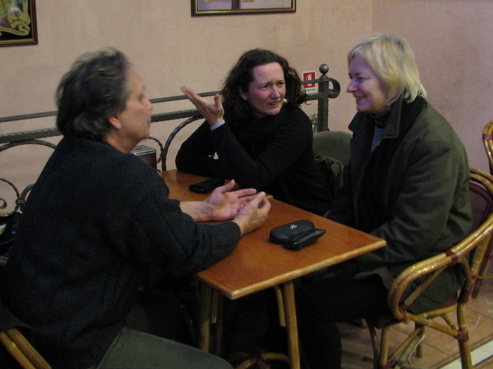
Gary, Manone, and Verlay
That’s what it’s all about folks: a cup of coffee, a few friends, and a foreign language. Check out new friends Manone, Brian, Verlay, and Claudio in the photos. Apologies to all for name misspellings and blurry pictures. Claudio’s son, Fedro, was with the group as well, but we didn’t get any pictures of him.

Manone and Brian
As a matter of fact, Fedro was just in from Berlin where he is currently residing. He’s an artist and musician and Berlin is one of those magnet places for such folks. He said he’d been all over Europe to all the major art scenes. Amsterdam, Prague etc. In Prague, he says, when you go to the café you end up staying all night, drinking and carousing with friends. Eventually all the people at separate tables join in together until there is only one big conversation. That’s how I always envisioned an any art scene: endless cups of coffee, late nights, no strangers, only friends.
This particular evening was not that long or the conversation as involved, but we did a have two or three drinks each. The group members were from all over: Holland, Ireland, France, Italy. Gary and I were the American contingent. Most of us had pretty bad Italian, so we defaulted to English. Ugh. At any rate we enjoyed sharing ethnic jokes and ranking out on Obama and Berlusconi. I think we even had a few jokes at the expense of the Queen of Holland. Hard to believe we could find something funny about a 90-year-old monarch in this day and age, but as Spaulding Gray once said: At cocktail hour, we let the judgments fly.
At any rate, this is why we travel. And drink coffee.

Verlay and Claudio


January 29, 2013
Postcards from Italy: Rome is…
 After I posted a book report over at Goodreads on The Dark Heart of Italy, a friend suggested I take a look at Paul Ginsborg’s A History of Italy. Seemed like a good excuse to run up to Rome and pick up a book, so I did. My destination was a little English title bookstore, Anglo-American Book Shop, on Via Della Vite, that I figured would have the book.
After I posted a book report over at Goodreads on The Dark Heart of Italy, a friend suggested I take a look at Paul Ginsborg’s A History of Italy. Seemed like a good excuse to run up to Rome and pick up a book, so I did. My destination was a little English title bookstore, Anglo-American Book Shop, on Via Della Vite, that I figured would have the book.
We got lost using the GPS function on Gary’s iPad. Street signs are hard to find here in Italy. Sometimes they’re on the buildings themselves, sometimes they are on poles like in the U.S. The wide avenues don’t have signage at all. Everybody knows what Via Nazionale is, so why do you need a sign?
Despite the fact that it was cold the streets were crowded. Everybody was out. It was Saturday and time for a walk after all. The outdoor cafes had heating devices placed strategically amongst the tables. They consisted of see-through cylinders with gas jets inside. Blue flames shot through the tubes, keeping the diners closest to the jets warmest.
We were hungry by the time we found the store and made our purchase. One of my favorite things in the whole world is to be hungry in Rome. To be hungry in Rome is to find meaning in your life. There is no better position to be in than hungry in Rome.
We searched for about a tenth of a block for an appropriate place to eat. As is typical of Italian eateries, it was small on the outside, and endless with backrooms on the inside. We found a little nook in back complete with wine in a basket, checkered table cloth, and MTV featuring Gangnam Style on the flatscreen above our heads. How romantic. I ordered papardelle with a porcini sauce. Comfort food. Delicious and rib-sticking. I had no need for dinner later. Gary had…something else. The wine was great, the bread fresh out of the oven, the cappuccino passable.
We slept on the train ride home.
I have a hard time writing on Rome because I don’t have anything to add to the trillions of words that have already been published on the subject.
I don’t even know what to photograph. It’s all so…Romish. Following on from my post on graffiti, I thought I should include the lovely sample up above that I shot in the train yard. (That’s actually the train to Frascati by the way. We were on the wrong platform. Fortunately there’s always another train to Frascati.)
Here’s my sum up:
Rome is…
…old;
…beautiful;
…crowded even in mid-winter;
…mysterious;
…eternal.
There I said it. Hopefully I’ll find another excuse to head up there and spend enough time to write a more serious contribution on Rome. Meanwhile, I’m going to go and read my book.
Thanks for checking in,
P.S. Don’t forget to sign up for the newsletter to get news about the upcoming washing machine contest and your chance to win free books and music CDs.


January 24, 2013
Postcards from Italy: Villa Aldobrandini

Villa Aldobrandini
I read in some brochure that the town I’m living in, Frascati, is known for its many villas. I thought all Italian towns had these romantically creepy old structures, but apparently not. Frascati is singularly blessed. I’ve been trying to get out and see as many as possible while I’m here. I love ‘em.
There’s Villa Lancellotti, practically in my back yard. I’m not sure that’s the right way to put it. I don’t have a backyard and the Lancellotti family has hundreds of acres for theirs. So actually…

Villa Lancellotti
Up the road from Lancellotti is Villa Tuscolana, which has been converted to a hotel and ristorante. If such a thing was moved over to the U.S. they’d call it a B&B. And if B&Bs in America were hundreds of years old, made of stone, and about ten times bigger than what they are now, it would look like one of these–I don’t know what to call them–Castles without a moat? Mansions as big as an ocean liners? Big, ostentatious monstrosities, built on the backs of the ever-suffering proletariat of centuries past?
I love ‘em.
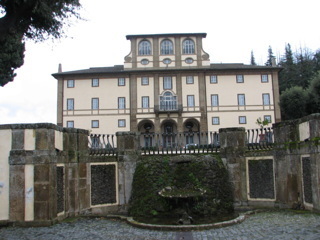
Villa Tusculana
Down the hill from Tuscolana and across the moor from Lancellotti is Villa Falconieri. I tried to get in to take a photo, but I got kicked out. The grounds are not open to the public. Best I got was the back side of the entrance gate.
You can see Villa Torlonia from all over Frascati. It’s not as magnificent as Lancellotti or Tuscolana; it looks a lot like a big YWCA. Because you can see Torlonia from all over town, though, it gets points for in-your-faceness.
There are a ton more that I’ve yet to see, but without doing a comprehensive survey I can tell you now the most impressive of all is Villa Aldobrandini.
Villa Torlonia
The picture at the top of the post does not do Adobrandini justice. When you first see it, it takes your breath away. Many tourists step off the bus, are overwhelmed by the view of Aldobrinidini on the hill, and turn right back around and head back to Rome. Like the Grand Hotel on Macinac Island, you just don’t need to see anything else after viewing such a monument to humanity’s hubris.In a way this structure and its accompanying grounds stand as a symbol for the entire town. All over Frascati in lobbys and offices you see old-fashioned photos and maps of Aldobrandini proudly displayed. As if that’s the only story needing to be told. It’s not just its size, but its placement that excites the awe. No matter how you enter the city, it’s the first thing you see. And it totally rules the town by virtue of its chutzpah.
It sits magnificently on the hill with a grove of trees pruned in the draconian Italian style and leading straight up to the “castle.” So chokingly manicured are these trees you suspect that, like the bound-footed Asian women of yore, they have suffered for their beauty. It’s a wonderful effect, but wholly unnatural and somewhat stifling to behold. In this case the trees serve to remind you of what? Punishment if you don’t worship the residents of the Aldobrandini home?
Supposedly an Italian prince does live there occasionally. I wonder how I’m supposed to behave when he comes to town. Are the Frascatani expected to stay indoors lest our eyes fall upon his visage? Or do we turn out to cheer for his motorcade as it tools up Viale Vittorio Veneto?
In truth Aldobrandini is looking a little shabby. The grounds need some care, the trees are getting scraggly, the lawn patchy. Everything’s old and crumbly. That’s sort of the way of things in Italy, but Aldobrandini’s crumbly contrasts sharply with the nattiness of such places as Villa Tuscolana that caters to wealthy outsiders. Aldobrandini looks run down. Don’t get me wrong it’s still impressive up on the hill like that, jutting from the trees below. It’s creepily romantic. And beautiful. I love it.
There’s a bridge over the road that separates the Lancellotti estate from the Aldobrandini one. I keep thinking of the bored Lancellotti daughters of a few centuries back. I think they pined for entertainment. Did they sneak across the road to take a peak at the Aldobrandini princes? Did they don the vestments of a boy and climb over the wall at night for clandestine rendezvous? I hope so.
Thanks for reading,
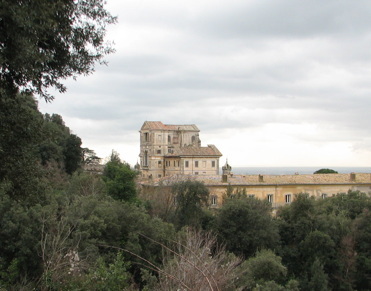
Aldobrandini from the side


January 20, 2013
Postcards from Italy: graffiti
 Italy loves graffiti. From the look of the word, I’d guess they invented it. I like some graffiti. If it’s particularly artful or politically interesting I admire it. Most graffiti is not that. But I think the more you pay attention, the more you start to recognize the good stuff. I’m not there yet, but I’m starting to look and analyze. Here in Frascati you occasionally see the “x loves y” announcements that typically decorate boulders and underpasses at home. More often though, in and amongst the more common tags, you’ll find some sort of interesting slogan. I think they’re warnings or threats, or maybe food suggestions. I recognize the words for fear, renew, question, always, never, ask, dark, but can’t make sense of the context. The circled A for anarchy (another Italian word perhaps?) is more prevalent than the swastika. I take comfort in that.
Italy loves graffiti. From the look of the word, I’d guess they invented it. I like some graffiti. If it’s particularly artful or politically interesting I admire it. Most graffiti is not that. But I think the more you pay attention, the more you start to recognize the good stuff. I’m not there yet, but I’m starting to look and analyze. Here in Frascati you occasionally see the “x loves y” announcements that typically decorate boulders and underpasses at home. More often though, in and amongst the more common tags, you’ll find some sort of interesting slogan. I think they’re warnings or threats, or maybe food suggestions. I recognize the words for fear, renew, question, always, never, ask, dark, but can’t make sense of the context. The circled A for anarchy (another Italian word perhaps?) is more prevalent than the swastika. I take comfort in that.
The attached photo is the best graffiti I’ve come across so far. Not the tags in the foreground but the faded statement in pink. It illustrates the cockeyed way the world perceives America at times*, but also the way Italians never let anything go. I mean, this graffiti has to have been on that wall since the 70s. Stuff lasts here in Italy. I take comfort in that too.
*But let me ask you this: Is there any American leader in the past 40 years that some American somewhere hasn’t compared to Hitler? It’s not just the world that perceives us that way, we do ourselves.


Sue Lange's Blog
- Sue Lange's profile
- 19 followers


